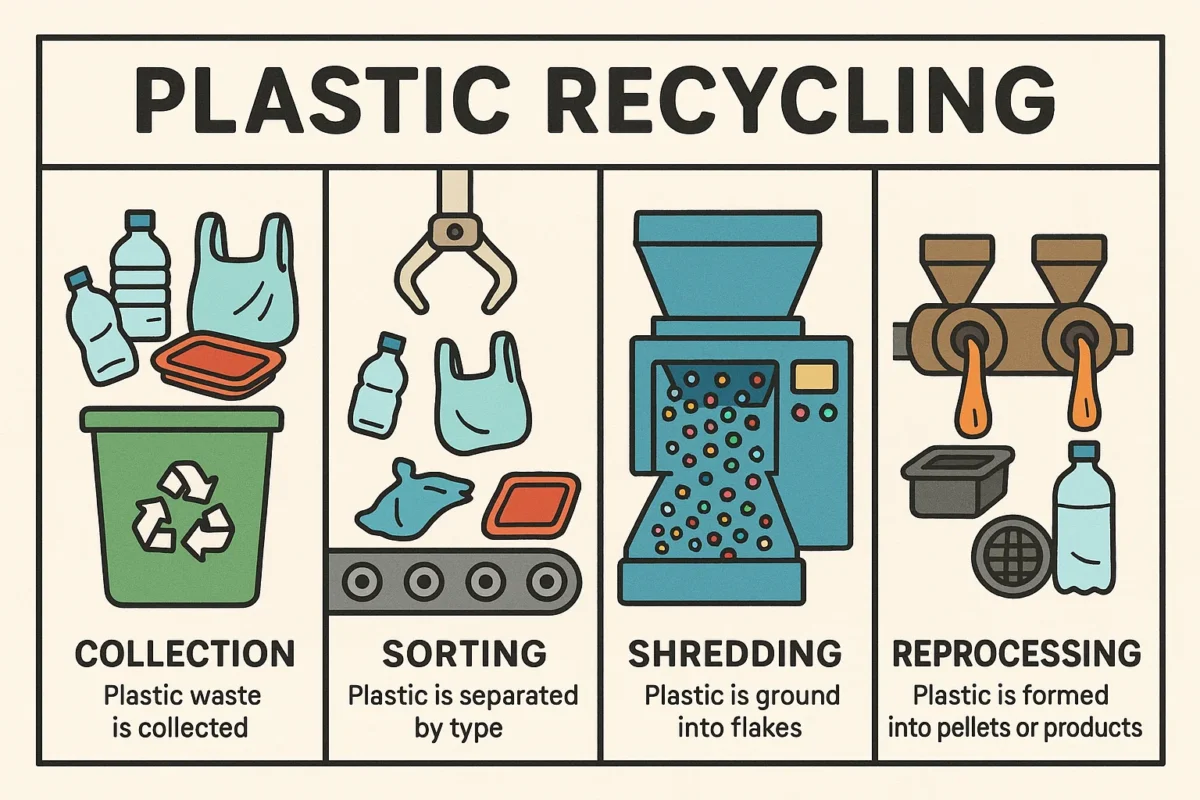في Rumtoo, we provide comprehensive recycling solutions for transforming plastic waste into valuable resources.
♻️ The Four Key Stages
Plastic recycling is a multi-step process that transforms used plastic products into raw materials that can be used to create new items. Understanding each stage helps us appreciate the complexity and importance of proper plastic disposal.
🔍 Stage 1: Sorting
The first critical step in the recycling process is sorting plastic materials by type and color.
<aside> ℹ️
Why Sorting Matters Different types of plastics have different chemical compositions and melting points. Mixing them can compromise the quality of the recycled material.
</aside>
What happens during sorting:
- Plastics are separated by resin type (PET, HDPE, PVC, LDPE, PP, PS, and others)
- Materials are categorized by color
- Non-recyclable items and contaminants are removed
- Both manual sorting and automated systems using infrared sensors are employed
Common plastic types:
- PET (#1) – Water bottles, food containers
- HDPE (#2) – Milk jugs, detergent bottles
- PVC (#3) – Pipes, window frames
- LDPE (#4) – Plastic bags, squeeze bottles
- PP (#5) – Yogurt containers, bottle caps
- PS (#6) – Foam cups, packing materials
✂️ Stage 2: Shredding
Once sorted, the plastic materials are mechanically shredded into small pieces or flakes using specialized أداة تقشير equipment.
The shredding process:
- Large plastic items are fed into industrial shredders
- Materials are cut into uniform small pieces (typically 8-10mm in size)
- This increases surface area for more efficient washing
- Shredded pieces are easier to transport and process
Key Benefit Shredding transforms bulky plastic waste into manageable flakes, making subsequent processing steps more efficient and effective.
🧼 Stage 3: Washing
The shredded plastic flakes undergo a thorough cleaning process to remove contaminants using advanced Washing Line systems.
What gets removed:
- Labels and adhesives
- Dirt and grime
- Food residue
- Other impurities
The washing process includes:
- Pre-washing – Initial rinse to remove loose debris
- Hot water washing – Using detergents to break down oils and stubborn residues
- Friction washing – غسالة بالتدريب provides mechanical agitation to scrub the flakes
- Rinsing – Multiple rinse cycles with clean water
- التجفيف – Removing moisture before the next stage
Environmental Note Modern recycling facilities recycle and treat the wash water to minimize environmental impact and reduce water consumption.
🔵 Stage 4: Pelletizing
The final stage transforms clean plastic flakes into uniform pellets ready for manufacturing through Plastic Pelletizing technology.
The pelletizing process:
Step 1: Melting
- Clean, dry flakes are fed into an extruder
- Heat and pressure melt the plastic (temperatures vary by plastic type)
- The molten plastic is homogenized to ensure consistency
Step 2: Extrusion
- Melted plastic is forced through a die to create long strands
- These strands resemble spaghetti-like strings of plastic
Step 3: Cooling
- Strands pass through a water bath to solidify
- Quick cooling helps maintain structural integrity
Step 4: Cutting
- Cooled strands are cut into small, uniform pellets
- Pellets are typically 2-5mm in size
- Final product resembles small plastic beads
End Product These recycled plastic pellets (also called nurdles) are the raw material for manufacturing new plastic products. They can be sold to manufacturers and used just like virgin plastic pellets.
🔄 The Complete Cycle
After pelletizing, the recycled plastic pellets are ready to begin a new life:
- Textile manufacturing – Fleece jackets, carpets, and fabrics
- التعبئة والتغليف – New bottles and containers
- Construction materials – Plastic lumber, piping, and composite materials
- قطع غيار السيارات – المكونات الداخلية والتزيين
- Consumer goods – Furniture, toys, and household items
💡 Key Takeaways
- Quality matters: Proper sorting at the source (your home!) makes the entire process more efficient
- Clean recycling: Rinse containers before recycling to reduce contamination
- Know your numbers: Check the recycling codes on plastic items to understand what can be recycled in your area
- Reduce first: Remember that recycling is just one part of the solution—reducing plastic consumption is even better
By understanding each stage of the plastic recycling process, we can make better choices about our plastic use and disposal, contributing to a more sustainable future.

